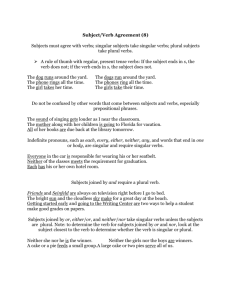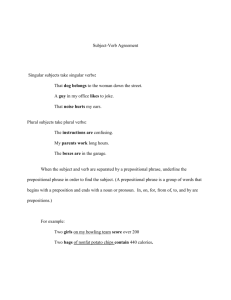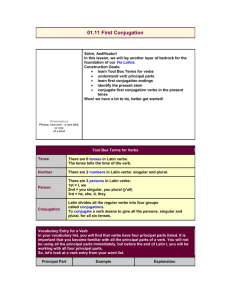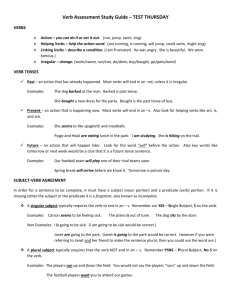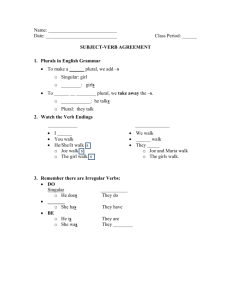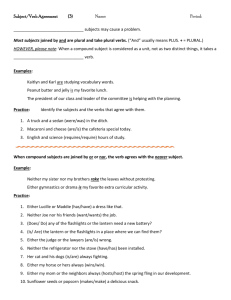latin ii midterm study guide – 2011-2012
advertisement
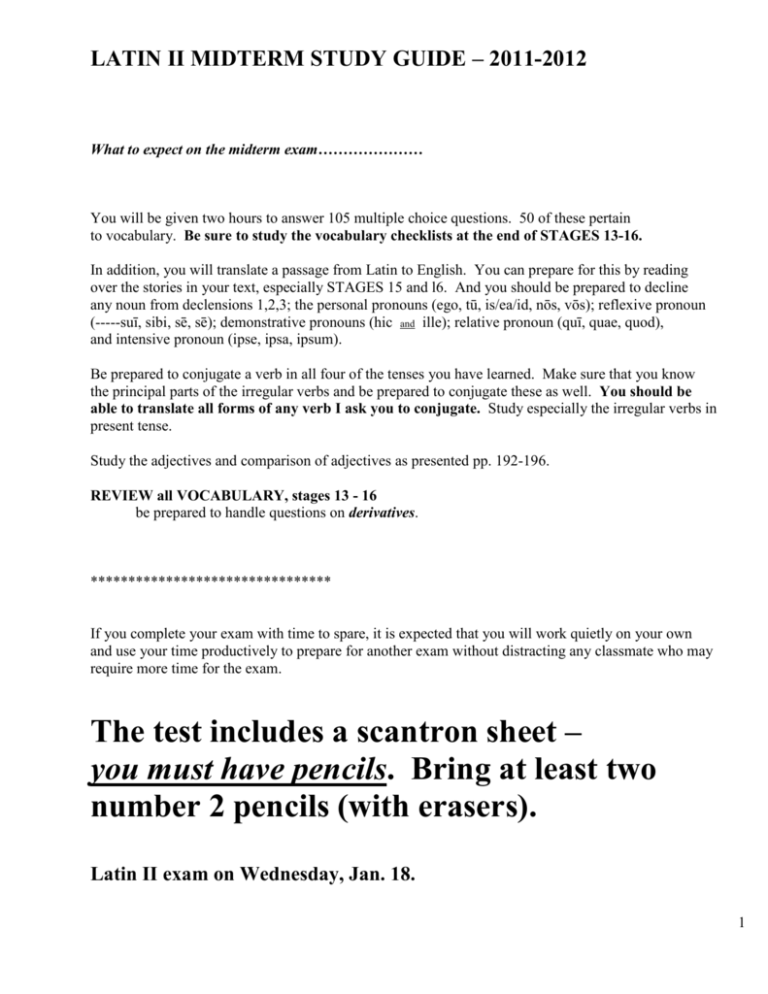
LATIN II MIDTERM STUDY GUIDE – 2011-2012 What to expect on the midterm exam………………… You will be given two hours to answer 105 multiple choice questions. 50 of these pertain to vocabulary. Be sure to study the vocabulary checklists at the end of STAGES 13-16. In addition, you will translate a passage from Latin to English. You can prepare for this by reading over the stories in your text, especially STAGES 15 and l6. And you should be prepared to decline any noun from declensions 1,2,3; the personal pronouns (ego, tū, is/ea/id, nōs, vōs); reflexive pronoun (-----suī, sibi, sē, sē); demonstrative pronouns (hic and ille); relative pronoun (quī, quae, quod), and intensive pronoun (ipse, ipsa, ipsum). Be prepared to conjugate a verb in all four of the tenses you have learned. Make sure that you know the principal parts of the irregular verbs and be prepared to conjugate these as well. You should be able to translate all forms of any verb I ask you to conjugate. Study especially the irregular verbs in present tense. Study the adjectives and comparison of adjectives as presented pp. 192-196. REVIEW all VOCABULARY, stages 13 - 16 be prepared to handle questions on derivatives. ******************************** If you complete your exam with time to spare, it is expected that you will work quietly on your own and use your time productively to prepare for another exam without distracting any classmate who may require more time for the exam. The test includes a scantron sheet – you must have pencils. Bring at least two number 2 pencils (with erasers). Latin II exam on Wednesday, Jan. 18. 1 LATIN ALPHABET Latin had 23 letters, missing the letters ‘j’, ‘u’, and ‘w’. However, your textbook uses the letter ‘u’. So for the purposes of your textbook, and thus also for your purposes, the Latin alphabet has 24 letters. Before you begin your review, make sure that you know the rules for word accent! Be sure, too, that you know the 6 diphthongs: ae, au, ei, eu, oe, ui There are 6 short and 6 long vowels in Latin (a,e,i,o,u,y). Including the 6 diphthongs, there are 18 basic vowel sounds in Latin. WORD ACCENT Vowel length is important for determining syllable length. And syllable length is important for determining word accent. Remember, word accent goes on the penult. In words of 3 or more syllables, accent goes on the penult but only if it is long. Thus, you only need to figure out where accent goes in a word of 3 or more syllables. e.g. / a / mī / cus When the penult is short, the accent goes on the antepenult. e.g. / ae / di / fi / ci / um Any syllable containing a long vowel sound (vowel with macron or diphthong) is long. A syllable may also be long by position if it is closed by a consonant. In the following example, even though all the vowels are short, the penult concludes with a consonant and is therefore long by position. e.g. / an / cil / la I. NOUNS By now, you should know the first three declensions inside and out. If not, take this opportunity to learn them! Your effort now will pay off as we soon will add the 4th and 5th declensions (which are not, BTW, on your midterm). 2 NOUNS ~ be prepared to decline nouns from each declension, all cases, singular and plural. Study the following chart for case endings of 1st, 2nd, and 3rd declension nouns. CASE Nom. Gen. Dat. Acc. Abl. 1st Sing. -a -ae -ae -am -ā 1st Pl. -ae -ārum -īs -ās -īs 2nd Sing. -us -ī -ō -um -ō 2nd Pl. -ī -ōrum -īs -ōs -īs 3rd Sing. --is -ī -em -e 3rd Pl. -ēs -um/-ium -ibus -ēs -ibus →→→→→→Determine the declension to which a noun belongs by its genitive singular ending. Choose words from each declension (1,2,3) and practice declining them, singular and plural, in all cases. Do this multiple times on separate paper. Procedure for declining nouns: always write out nominative and genitive as illustrated below by declension: 1st via, viae 2nd amīcus, amīcī 3rd mercātor, mercātōris …..then, FIND THE NOUN STEM by removing genitive singular ending: via, vi∕ae amīcus, amīc∕ī mercātor, mercātōr∕is NOUN STEMS: vi- …….add other case endings amīc- mercātōr- NOW PRACTICE!!!!!! ………. Make sure you know the function(s) of each of the following cases in a Latin sentence. Nominative (2 functions) – 1) subject (completes action of verb) 2) predicate nominative with linking verb ~ predicate noun ~ predicate adjective Genitive – possession → Steve Warden wrestles. → Steve Warden is a wrestler. → Steve Warden is invincible. → Emily hid Mary’s cell phone. 3 Dative – (3 functions) 1) indirect object 2) dative of advantage 3) object of special verbs → → → I gave the book to you. I made this study guide for you. …crēdō, faveō, pāreō, appropinquō, obstō, persuādeō, respondeō….etc. et et cētera = and the rest Accusative – (2 functions) 1) direct object → Tyler completed his applications for college. 2) object of certain prepositions …… ad (to), per (through), trāns (across), prope (near), in (into, against), apud (at house of) [a preposition governs accusative if it IS NOT sid space] N.B. When ‘in’ governs accusative, it has a different meaning from SID SPACE ‘in’. Ablative - object of certain prepositions SID SPACE – …… the ABLATIVE astronaut sine (without) in (in) dē (down from, about, concerning) sub (under) prō (before, in front of, on behalf of) ā/ab (away from, from) cum (cum) ē/ex (out of) Practice writing them: S I D S P A C E [it helps to remember ………. ‘cum’ ≠ ‘sine’] Also… ā/ab and ē/ex function in Latin the same way as ‘a’ and ‘an’ in English Remember, ‘a’ and ‘an’ do not exist in Latin. But they can be implied from context. Vocative - direct address → “Hey Derulo. Wake up!” Learn the vocative rule. Vocative = nominative in singular and plural EXCEPT for the 2nd declension masculine (singular only) ending only in ‘-us’ or ‘-ius’ ‘-us’ → ‘-e’ amīcus → amīce ‘-ius’ → ‘-ī’ fīlius → fīlī 4 Vocative Hey Derulo! The vocative is used in direct address especially in commands. (cont.) BE GRATEFUL that vocative is generally the same as nominative singular or plural. So if it’s not 2nd declension masculine ending in ‘-us’ or ‘-ius’ …… ……then the vocative is exactly the same as the nominative! This means, too, that other 2nd declension masculines like ‘vir’ and ‘puer’ remain unchanged in the vocative. “Derulo! Be grateful!” APPOSITION Two nouns placed next to each other (ad = to, near + position) where the 2nd noun gives more info about the 1st. e.g. Ms. Koslowski, our school principal, is an excellent role model for students. VERBS There are four conjugations of verbs that each follow their own same pattern. Think of the ‘verb conjugation’ as a ‘verb family’. The four conjugations are said to be ‘regular verbs’. Verbs that do not fall into a regular conjugation are called ……‘irregular’. For this exam, you must be able to identify the conjugation to which a verb belongs. Determine the conjugation by its infinitive (2nd principle part): remember that the infinitive means …… ‘to verb’ 1st -āre 2nd -ēre →→→→ 3rd -ere → for 2nd conjugation verbs, the first person singular, present ALWAYS ends in ‘-eō’ note that the ‘-e’ is short here in the 3rd conjugation 4th -īre N.B. [ = notā bene] Any verb that does not have these infinitive endings is………IRREGULAR. In your own words, explain below the difference between 2nd and 3rd conjugations: 5 Besides being able to identify the conjugation of a verb, you also need to know the Principal parts of the verb. The principal parts are important because they enable us to determine the stem needed to form the verb in the tenses we have learned. So far, you have learned four (4) tenses: Present Imperfect Perfect Pluperfect Before going any further, let’s review the PRINCIPAL PARTS! Most Latin verbs have FOUR (4) principal parts: C O N J U G A T I O N S 1st 2nd 3rd 4th Present tense Infinitive Perfect tense ……coming soon 1st amō amāre amāvī ……coming soon 2nd dēbeō dēbēre dēbuī ……coming soon 3rd dīcō dīcere dīxī ……coming soon 3rd –iō faciō facere fēcī ……coming soon 4th veniō venīre vēnī ……coming soon N.B. NOTE that you can begin distinguishing conjugations from the 1st principal part. But it’s the 2nd principal part (infinitive) that is definitive for each conjugation. 6 To form present and imperfect tenses, use stem from 2nd principal part. …….simply remove ‘-re’ ….then add the appropriate endings. B BASIC VERB ENDINGS MOST MUST I’SNT m/ō I s t mus tis nt you he,she,it we you they PRESENT TENSE 1st and 2nd conjugations are formed the same way. Find the ‘present’ verb stem by removing ‘-re’ from the infinitive (2nd pp.). Then add endings. Just like you have a procedure for nouns, follow this one for verbs. ALWAYS WRITE OUT PRINCIPAL PARTS FIRST. This way you won’t make mistakes! 1st amō, amā/re 2nd → present stem = conjugate: amō amās amat amāmus amātis amant amā dēbeō, dēbē/re → present stem = dēbē conjugate: I love you love he,she,it loves we love you all love they love NOTE that the first principal part dēbeō dēbēs dēbet dēbēmus dēbētis dēbent I owe; I ought you owe; you ought he,she,it owes; he,she,it ought we owe; we ought you all owe; you all ought they owe; they ought IS the first person singular present!!!! 7 4th conjugation verbs in present tense work pretty much the same way as 1st and 2nd except that the letter ‘u’ is added in the 3rd person plural. veniō, venī/re veniō venīs venit venīmus venītis veniunt → present stem = I come you come he,she,it comes we come you all come they come venī In the verb system, note that the stem vowel -ā,ē,ī (1st, 2nd, 3rd conjugations) is ALWAYS SHORT in 3rd person before letters ‘t’ or ‘nt’. veni Unt (note that the ‘i’ becomes short before the ‘u’) 3rd conjugation works differently in present tense. The stem vowel changes from ‘-e’ to ‘-i’. dīcō, dīce/re → present stem = dīce 2 mnemonics may help. o ….. 4 i’s… u FISHOOK o i i i i u dīcō dīcō dīcis dīcit dīcimus dīcitis dīcunt I say you say he,she,it says we say you all say they say dīcis dīcit dīcimus dīcitis u dīc nt 8 IMPERFECT TENSE Simply add –ba to the present stem + personal verb endings (most,must,isn’t). Note, however, that 1st person singular ending here is ‘–m’. The ‘imperfect’ sheep goes -baaaaaaaaaaaaaaaaaaaa. -bam -bas -bat -bamus -batis -bant Formed the same way in 1st, 2nd, and 3rd regular conjugations. 1st amō, amā/re → present stem = amā → amābam 2nd dēbeō, dēbē/re → present stem = dēbē → dēbēbam 3rd dīcō, dīce/re → present stem = dīce → dīcēbam (‘-e’ becomes long…..) ……….difference for 4th conjugation and 3rd conj. ‘-iō verbs 4th veniō, venī/re → present stem = venī → veniēbam 3rd -iō faciō, face/re → present stem = face → faciēbam While 4th conjugation imperfect adds the letter ‘-e’, 3rd conjugation adds the letter ‘-i’. …..bottom line: 3rd and 4th conjugation imperfect look the same! PERFECT AND PLUPERFECT TENSEs…… EASY. EASIER. EASIEST. “Be grateful, Derulo!” The 3rd principal part IS the 1 st person singular perfect. Establish the perfect stem by removing the ‘-ī’ and you’re ready to add the other endings. PERFECT AND PLUPERFECT TENSE ARE FORMED THE SAME WAY FOR ALL VERBS! euge! euge! means __________________ 9 PERFECT TENSE ENDINGS PLUPERFECT TENSE ENDINGS ī istī it imus istis ērunt eram erās erat erāmus erātis erant Since the perfect and pluperfect are formed the same way for ALL verbs, you can practice with any verb you like. However. it all boils down to knowing the principal parts. You MUST learn the principal parts of every verb you meet. SUGGESTION: practice these tenses using verbs whose principal parts you have trouble remembering. E.g. the irregular verbs. Here is a 3rd –iō verb. Remember, start with the principal parts! 1st 2nd 3rd 4th Present tense Infinitive Perfect tense ……coming soon faciō facere fēcī ……coming soon fēc/ī → perfect stem = fēc PERFECT TENSE fēcī fēcistī fēcit fēcimus fēcistis fēcērunt PLUPERFECT TENSE I have made you have made he,she,it has made we have made you all have made they have made fēceram fēcerās fēcerat fēcerāmus fēcerātis fēcerant ērunt I had made you had made he,she,it had made we had made you all had made they had made Remember the mnemonic I gave you for recognizing the perfect tense stem. Perfect tense indicator: SUV x(tra) LONG reduplicated (this is on my web page, see VERBS, left sidebar) 10 ON TRANSLATING PERFECT AND PLUPERFECT TENSES NOTE THAT I have translated each tense with a helping verb: ‘have verbed’ = perfect; ‘had verbed’ = pluperfect. The helping verb is called the auxiliary verb. Please learn this word! That’s right, Derulo! (yup, gotta sneak in another vocative….). The Latin word for help is auxilium. The English word, auxiliary is a derivative. And because this English derivative looks exactly like its Latin root, it is called a cognate. ALL perfect system tenses have auxiliary (helping) verbs. PERFECT I have ‘verbed’ PLUPERFECT I had verbed (and in the future perfect to learn next year) I will have verbed W When you think that the perfect ‘have verbed’ sounds dopey, you’re right! But because the other two perfect system tenses ALWAYS have the auxiliary verb, you may find it helpful to construe the perfect tense this way too. Thus, always a ‘helping verb’ for the perfect system tenses. Depending on context, you can modify your perfect tense translation for better English. In bibliothēcā heri discipulōs meōs vīdī. ………..how’s this for a dopey translation: Yesterday I have seen my students in the library. modify to: Yesterday I saw my students in the library. IRREGULAR VERBS…. sum, esse, fuī, futūrus possum, posse, potuī volō, velle, voluī nōlō, nōlle, nōluī eō, īre, īi, itum ferō, ferre, tulī, lātus tollō, tollere, sustulī, sublātus (tollō = regular, 3rd conjugation verb. Notice that it shares principal parts with ferō) 11 Fill in the principal parts of the verb volō, _____________, ______________ (to want). In the space below, conjugate volō in the present tense. Person Singular Plural 1st 2nd 3rd Fill in the principal parts of the verb nōlō, _____________, ______________ (to not want). In the space below, conjugate nōlō in the present tense. Person Singular Plural 1st 2nd 3rd Fill in the principal parts of the verb possum, _____________, ______________ (to be able). In the space below, conjugate possum in the present tense. Person Singular Plural 1st 2nd 3rd These irregular verbs are usually followed by a complementary infinitive, i.e., [= id est or ‘that is’] the ‘complementary infinitive’ completes the meaning of the verb. e.g. [exemplī grātiā]….. for example Tyler is able to hit the ball out of the park. (‘to hit’ tells what Tyler ‘can verb’) The present active infinitive is the ________________ principal part of a verb. The _________________ principal part of a verb tells us its conjugation. PRACTICE YOUR Verb Conjugations on another sheet of paper. For regular verbs, see p. 202. Irregular verbs pp. 206-07. Don’t neglect: ‘sum’, ‘eō’, ‘ferō’ 12 THE IMPERATIVE IS USED FOR MAKING COMMANDS The imperative singular is the same as the ‘present stem’. To form the imperative plural, add ‘-te’ to the present stem. “Surge, Derulo.” “Stand up, Derulo!” N.B. The imperative (verb) is used with noun in direct address (vocative case). Formation of the imperative as follows: SINGULAR PLURAL 1st amō amāre → amā amāte 2nd dēbeō dēbēre → dēb ē dēbēte 3rd surgō surgere → surge surgite 3rd –iō capiō capere → cape capite 4th veniō venīre → venī venīte Note the ‘fishhook’ vowel change to a short ‘i’ in 3rd conjugation imperative plural. i.e. the stem ending changes fro ( -e ) to ( -i ). e.g. mitte → mittite Irregular imperatives Mnemonic: dīc, dūc, fac, fer HAD an -e but lost it somewhere........... for the most part, the plural has no surprise: dīcite, dūcite, facite........... ferte (ferte is still....weird) The plural of the first three are regular 3rd conjugation verbs. Note that the imperative plural for these is formed the same way as for all other 3rd conjugation verbs. 13 SINGULAR PLURAL dīcō, dīcere → present stem = dīce BUT dīc dīcite dūcō, dūcere → present stem = dūce BUT dūc dūcite faciō, facere → present stem = face BUT fac facite fer ferte ferō, ferre = IRREGULAR VERB The negative imperative is formed using nōlī + infinitive for singular, and nōlīte + infinitive for plural. Clēmēns, nōlī vīsitāre Poppaeam! (Clēmēns, don’t visit Poppaea) Clēmēns et Grumiō, nōlīte bibere aquam! ( Clēmēns and Grumiō, don’t drink the water) VERBS THAT GOVERN THE DATIVE........... I repeat this because it’s important…… You must learn to recognize these. For example, pāreō appropinquō faveō credo Many compound verbs such as persuādeō respondeō appropinquō and obstō When you can’t figure out the case of a word that looks “dablative”, and more especially when you expect that word to be accusative, most of the time the word will be dative because of the verb This useful guideline enables you to dispense memorizing all 150 + verbs that govern the dative case. PERSONAL PRONOUNS Correspond to verb endings POSSESSIVE ADJECTIVES m = ego (I) meus, mea, meum = my s = tū (you sing.) tuus, tua, tuum t = is, ea, id (he, she, it) no possessive adjective for 3rd person singular; use ‘eius’ = genitive of ‘is,ea,id’ mus = nōs (we) noster, nostra, nostrum tis = vōs (you all) vester, vestra, vestrum nt = eī, eae, ea (they) = your no possessive adjective for 3rd person plural; use ‘eōrum’ = genitive of ‘eī, eae, ea’ 14 Fill in the personal pronouns and adjectives below (copy from above). Pronoun Adjective 1st singular 2nd singular 1st plural 2nd plural Make sure that you can decline ALL the personal pronouns in singular and plural. See pages 197 section B and 201 section D in your textbook. REFLEXIVE PRONOUN see page 197, section C The ‘reflexive pronoun’ is dedicated to the 3rd person. Thus the same form works both in the singular and the plural because it simply ‘reflects’ (refers) to the subject. e.g. (Derulo! What does ‘e.g.’ mean?) Tyler saw himself in the mirror. Tyler left his book under his desk. → → Tyler sē in speculō vīdit. Tyler librum suum sub mēnsā suā relīquit. Reflexives for 1st and 2nd persons. These simply use the other cases of ‘ego’, ‘tū’, ‘nōs’, ‘vōs’ (or corresponding adjectives, see above). I saw myself in the mirror. → ego in speculō mē vīdī. I left my book under my desk. → ego librum meum sub mēnsā meā relīquī. You saw yourself in the mirror. → tū in speculō tē vīdistī. You left your book under your desk. → tū librum tuum sub mēnsā tuā relīquistī. 15 Demonstrative pronouns: CASE Nom. Gen. Dat. Acc. Abl. CASE Nom. Gen. Dat. Acc. Abl. SINGULAR Masculine Feminine Neuter Sing Sing . hic haec illa PLURAL Feminine Neuter Masculine PLURAL Feminine Neuter hoc SINGULAR Masculine Feminine Neuter Sing Sing . ille Masculine illud INTENSIVE PRONOUN ipse, ipsa, ipsum is the intensive pronoun and is translated ‘himself’, ‘herself’, ‘itself’. CASE Nom. Gen. Dat. Acc. Abl. SINGULAR Masculine Feminine Neuter Sing Sing . ipse ipsa Masculine PLURAL Feminine Neuter ipsum 16 Relative pronouns introduce relative clauses. Relative pronouns agree with their antecedent in gender and number, but not case. The case of a relative pronoun is determined by its use in its own clause. This does not, of course, mean that the relative pronoun cannot be in the same case as the word to which it refers. But this happens due to its use in its own clause, and is therefore incidental! In the chart below, decline quī, quae, quod CASE SINGULAR Masculine Feminine Neuter Sing Sing . Masculine PLURAL Feminine Neuter Nom. Gen. Dat. Acc. Abl. PREPOSITIONS Here are a few prepositions that govern the ACCUSATIVE case. per: across apud: among, at the home of prope: near trāns: across …….remember, compare with SID SPACE…… Preposition practice (choose correct preposition + put the object in correct case): Translate into Latin – About the lion: ____________________ Across the forum: ____________________ Around the palace: ____________________ In the city: ____________________ Into the sea: ____________________ Out of the house: ____________________ Through the house: ____________________ To the arena: ____________________ Without the soldiers: ____________________ At father’s house ________________________ 17 ADJECTIVES Adjectives must agree with their nouns in gender, number, and case. A 1st /2nd declension adjective such as magnus,-a,-um and miser, misera, miserum will have 1st declension endings on the feminine and 2nd declension on the masculine and neuter. Decline “the happy friend” and “the outstanding sailor”. Careful! ‘nauta’ is masculine. CASE SINGULAR Nom. amīcus laetus PLURAL Gen. Dat. Acc. Abl. CASE Nom. SINGULAR PLURAL nauta optimus Gen. Dat. Acc. Abl. Review adjectives, pp. 192 – 193 and fill in the charts as suggested. Select some noun~adjective pairs of your own choosing from the word glossary in the back of your textbook. CASE SINGULAR Nom. leō miser PLURAL Gen. Dat. Acc. Abl. 18 CASE SINGULAR Nom. māter trīstis PLURAL Gen. Dat. Acc. Abl. CASE SINGULAR Nom. PLURAL puer fortis Gen. Dat. Acc. Abl. Get the gender of an adjective from the declension: first declension= feminine second declension = masculine or neuter Degrees of adjectives: Positive kind benignus, -a, -um Comparative more kind, kinder, rather kind benignior (m/f), benignius (n) Superlative most kind, kindest, very kind benignissimus, -a, -um The comparative adjective is used frequently (not only) when 2 things are being compared. When 2 things are not being compared, translate “rather + adjective”. Similarly for the superlative, if no comparison is being made, translate “very + adjective”. “quam” meaning “than” is used with the comparative. If “quam” is used then both things compared are in the same case. When “quam” is omitted, the 2nd thing compared is in the ablative case: This apple is prettier than that. Hoc mālum pulchrius quam illud est. OR Hoc mālum pulchrius illō est. 19 Degrees of Comparison See pages 194-195 in textbook longus (long) longior (longer) longissimus (very long, longest) positive comparative superlative Translations of quam 1.quam with a positive adjective = how quam pulcher est ānulus tuus. (How beautiful your ring is!) 2. quam with a comparative adjective = than Melissa est pulchrior quam Metella. (Melissa is more beautiful than Metella.) 3. quam with superlative adverb = as ___________as possible Quīntus ad vīllam quam celerrimē contendit. (Quīntus hurried as quickly as possible to the house.) 4. quam as the accusative singular feminine relative pronoun = whom / which Metella, quam Caecilius nōn vīsitāverat, erat īrāta. (Metella, whom Caecilium had not visited, was angry. QUESTION WORDS –ne [added to 1ST word of sentence ~ AKA, an enclitic] simple question with no particular answer expected (i.e. person might not know answer to his own question) estne Caecilius in vīllā? Is Caecilius in the farm house? nōnne [begins question expecting yes answer] nōnne Caecilius est mortuus? Surely Caecilius is dead, isn’t he? nōnne multī virī dōnum deō dedērunt? ___________________________________________ num [begins question expecting no answer] num Caecilius est laetus? Surely Caecilius is not happy, is he? num Rūfilla ipsa pecūniam tibi dēbēs? ___________________________________________ OTHER INTERROGATIVES quid: quis: ubi: cūr: quōmodo: quot: What… ? Who… ? Where.. ? Why…. ? How… ? How many… ? 20 ENCLITICS An enclitic is a word segment which is added to the end of a word with specific meaning. -que = et ......Maria et Tullia or Maria Tulliaque ( Tulliaque ) Note - from a visual perspective - how use of the (-que) pulls Maria and Tullia closer together!!!!! note, too, that word accent changes with the addition of an enclitic Túllia but -ne Tullíaque also an enclitic. Added to the first word of sentence = Roman style question mark ( ? ) The Romans did not actively use punctuation with any consistency. Use the enclitic ‘-que’ to rewrite the underlined section in the following sentence: Daedalus et Icarus nōn vīxērunt laetē. __________________________ REVIEW the Latin #’s 1 - 20 50, 100, 500, 1000 ….. only 1,2,3 and 1000 are declinable Study these short little words that are so hard to remember: deinde igitur ita vērō item tandem nam enim itaque tamen tum Random warnings: pōnō, pōnere, posuī, positus (to put, place) and possum, posse, potuī (to be able) have forms that look similar. Know the principals parts for both these verbs and practice conjugating them in the various tenses. ALSO, DO NOT CONFUSE imperfect and pluperfect of ‘possum’. ‘poterat’ ≠ ‘potuerat’ 21 CULTURE TOPICS: Roman Britain People to know: Icēnī Rēgnēnsēs Cantiacī Atrebatēs Durotrigēs Brigantēs It’s Raining Cats and Dogs Bad Agricola Boudica Cartimandua Celts Claudius Cogidubnus Icēnī Julius Caesar (was never emperor but rather a dictator; father of the 1st emperor, Augustus) Caesar was born in 100 B.C.E. and died on the IDES OF MARCH = March 15, 44 B.C.E. Augustus was emperor from 27 B.C.E. to 14 C.E. Regnensians (+ the other 5 Celtic tribes as noted in text) Calēdoniī Questions to consider: How did the Britons live before the Romans invaded Britain? What did the Romans bring? How were the Romans received? REVIEW all VOCABULARY, stages 13 - 16 be prepared to handle questions on derivatives. Review Culture & Historical Background, Stages 13-16 this means study and make sure that you know all the material pertaining to Roman Britain. Islands and bodies of water Mediterraneum Sea (mare nostrum), Mare Hadriāticum, Mare Tyrrhēnum Calēdonia = Scotland Lūsitānia = Portugal Ireland = Hibernia Islands off western coast of Italy: Corsica, Sardinia, Sicilia Meals of the day ientāculum, prandium, cēna yesterday, today, tomorrow heri, hodiē, crās 22 Pay attention in class, and make sure you remember some of the Latin expressions used commonly in English. e.g. = exemplī grātiā; festīnā lentē; etc. = et cētera Common Phrases, Quotes, and Abbreviations use the online exercises for Latin abbreviations on left sidebar of my webpage S.P.Q.R. (Senātus Populusque Rōmānus) = THE SENATE AND THE ROMAN PEOPLE. “vēnī, vīdī, vīcī” = I came, I saw, I conquered. ‘vīcī’ means I CONQUERED. dulce et decōrum est prō patriā morī = It is sweet and proper to die for one’s country. prō bonō = “ for free” e.g. = exemplī grātiā = for example choose 1st, 2nd, 3rd declensions nouns from the glossary in back of your book and practice declining in all cases, singular and plural conjugate some verbs in present imperfect perfect pluperfect ……….make sure you know the irregulars!!! Once you have finished the midyear exam, YOU WILL STILL BE RESPONSIBLE FOR THIS MATERIAL. SO KEEP UP YOUR HARD WORK! 23


